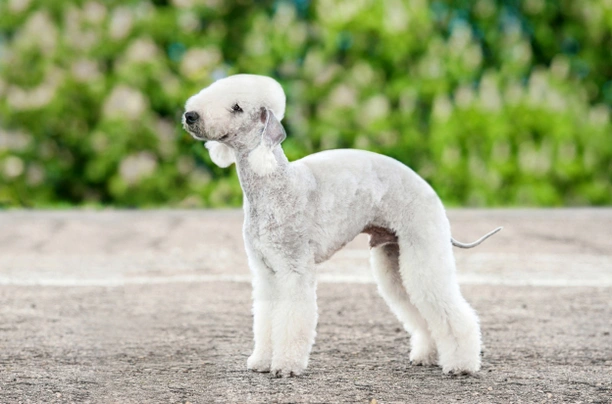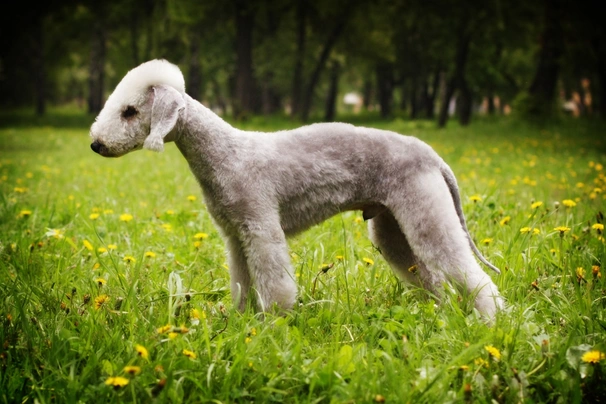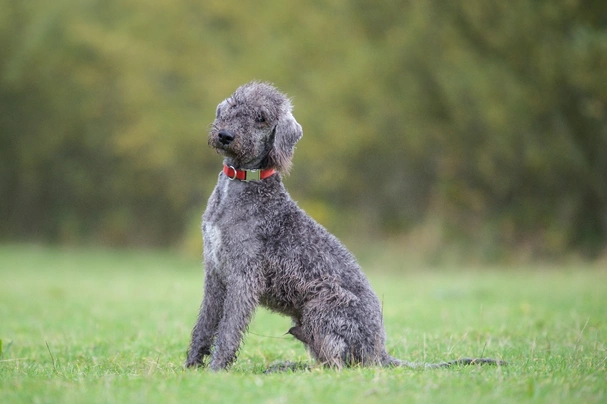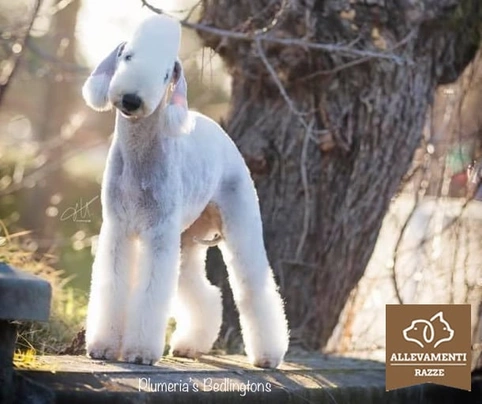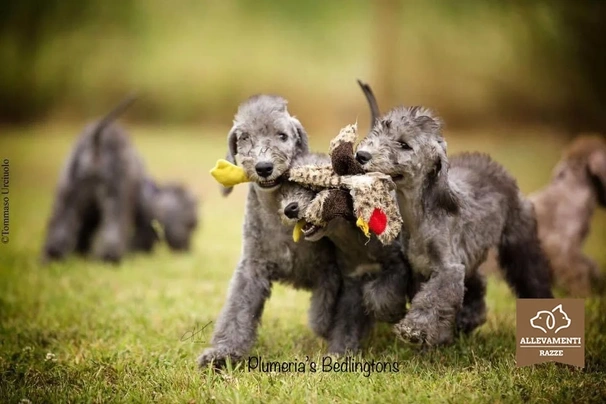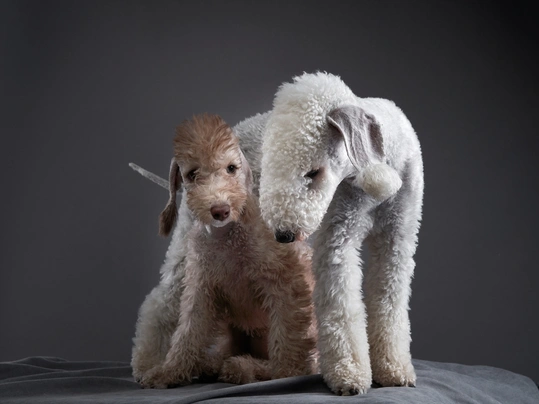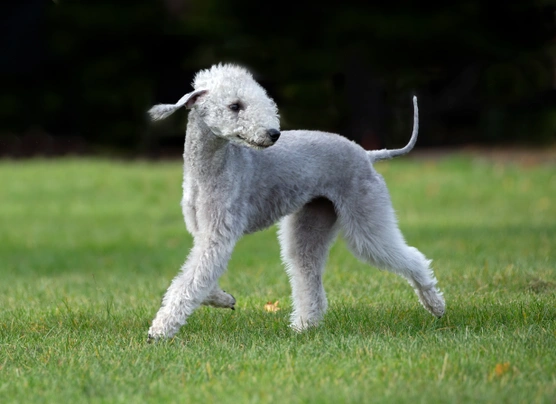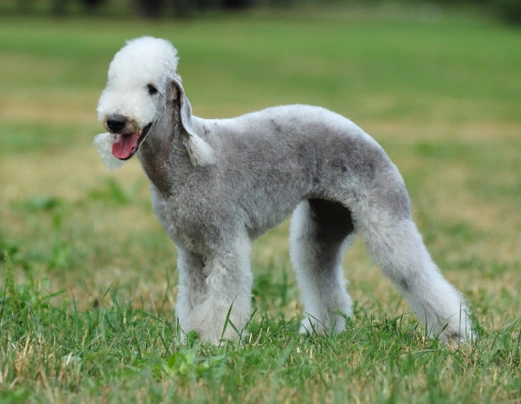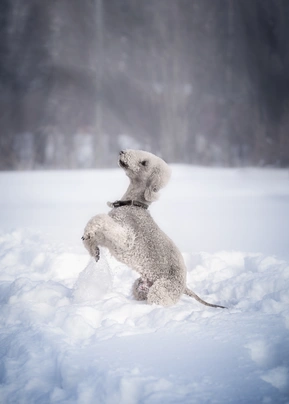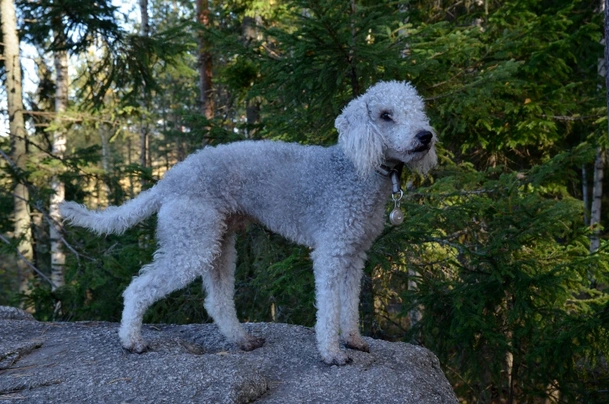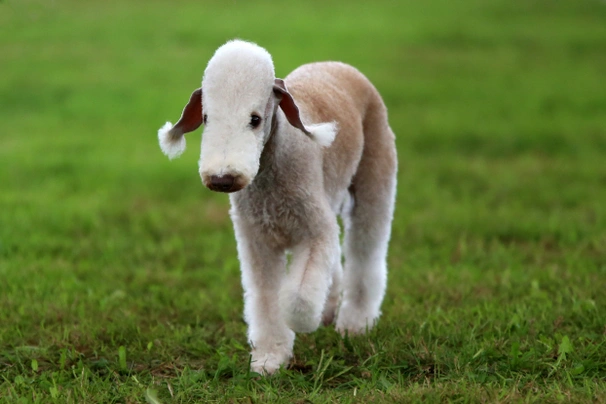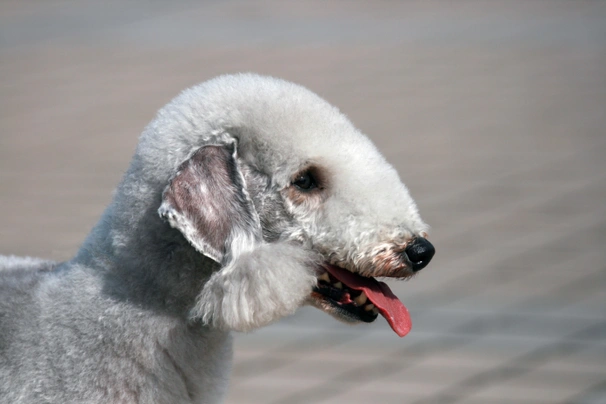Bedlington Terrier
Pros
Cons
Introduction of the Bedlington Terrier
The Bedlington Terrier is a quite unique looking dog that's often described as being "lamb-like" and they are renowned for being excellent companions and pets as well as being very popular in the showring. True to their terrier type Bedlingtons are "spirited and game" being highly skilled hunters in the field and remain so even when kept in a home environment. One of the oldest pedigree terriers around the Bedlington was originally bred in northern England but by 1877 their reputation for being extremely able hunters soon spread to other regions of the land. These dogs may look like lambs but they have the heart of a lion.
Today the Bedlington is a popular choice as a family pet not only because of their adorable looks but because of their kind sweet and good-tempered natures never forgetting that these small dogs are terriers at heart. As such they enjoy nothing more than to be out and about doing something rather than lounging around indoors. Bedlington Terriers are highly adaptable providing they are given the right amount of mental stimulation and daily physical exercise to keep them busy.
History of the Bedlington Terrier
The actual origins of the Bedlington Terrier remain a bit of a mystery with lots of different versions as to how the breed first came about. With this said it is thought that the Rough Scotch Terrier may be part of their ancestry and that they first appeared in a small village called Bedlington near the town of Rothbury which is why the breed is often referred to as a Rothbury Terrier.
In times past these small terriers were used by both poachers and gypsies to catch game on large estates. The gentry of the day soon realised that these terriers were extremely good at their job and hired the people who poached their land to rid their estates of unwanted vermin. Terriers were also a firm favourite with coal miners not only because they kept rat numbers under control but also because they were great sporting and racing dogs with the Bedlington being considered as being as good and sometimes faster than the Whippet.
There are those who believe that the Bedlington is a result of crossing various terriers that were commonly found in different areas of the country and as such these dogs were given the names of the regions where they were originally bred. This includes the Dandie Dinmont the Kerry Blue and the Soft Coated Wheaten Terrier with many believing that the Whippet too could be in the Bedlington's ancestry which gives them longer legs and slightly arched look.
One thing that is known about the breed is that these unique looking terriers originate from the hill country situated in the north of England and along the Scottish borders. It was Lord Rothbury who promoted the breed being a real enthusiast although back then they were called either Northumberland Terriers or Rothbury Terriers. Although it is not known exactly which type of terrier form the foundation of the Bedlington we see today there are those who believe the Dandie Dinmont and the Old English Terrier were crossed with Whippets and Otter Hounds to produce them.
The name Bedlington was given to the breed by Joseph Aynsley a breeder of the day who hailed from the town of Bedlington and who owned a dog called Aynsley's Piper. In 1869 the Bedlington Club was founded in the UK with the first breed classes finally being introduced at a dog show held in Newcastle in 1879. The breed was officially recognised by The Kennel Club in 1948. Over time these adorable looking and highly skilled terriers have found their way to many other regions of the world although to this day they remain quite a rare breed.
It was not until the 1900s that better breed records were kept because these terriers were fast becoming a popular choice not only as a hunting dogs but as a companion and show dogs too being a popular favourite in the ring. Today the Bedlington Terrier is one of the more popular breeds in the UK for these very reasons.
Interesting facts about the breed
- Is the Bedlington Terrier a vulnerable breed? No they are among one of the more popular breeds in the UK
- They are also known as Rothbury Terriers
- A Bedlington Terrier may look as sweet as a lamb but they are tenacious terriers that don’t give up easily when giving chase
- The breed was created using many terrier breeds and it’s thought there is Whippet in their ancestry too
- Bedlingtons excel at many canine sports which includes agility and earthdog trials
- They were a firm favourite with gypsies during the 17th century
- They are among the breeds that can trace an unbroken ancestry back to 1782
Appearance of the Bedlington Terrier
Height at the withers: Males 41 to 44 cm Females 38 to 42 cm
Average Weight: Males 7.7–10.4 kg Females 7.7–10.4 kg
Bedlington Terriers are unique looking little dogs that boast a graceful and lithe appearance. However they are strong and muscular with their extraordinary wedge-shaped heads giving them a striking appearance. They boast a very mild and gentle look about them which disguises well the fact they are true to their terrier breed and extremely keen skilled hunters.
One of the most defining physical traits of the Bedlington is the wedge shape of their heads which is profusely covered in almost white coloured hair and their silky top-knot. They boast longish tapering jaws with tight lips and well-defined large nostrils that all adds and enhances their overall lamb-like looks.
They boast small but very bright alert eyes which are a lovely triangular shape. Dogs with blue coats have darker eyes whereas dogs with blue and tan coats typically have lighter coloured eyes namely amber or light hazel. Their ears are neat and moderate in size being filbert shaped and set quite low with a flap that hangs neatly and flat to a dog's cheek. Ears are velvety to the touch and covered in fine short hair with tips having a little fringe of silky hair on them.
A Bedlington boasts a long and tapering neck that's deeper at the base and their forequarters are neat with dogs having nice straight front legs that are set quite wide apart on their chest. Their shoulders slope neatly and their bodies are well proportioned with a curved topline down to muscular hindquarters. Back legs should appear to be longer than a dog's front legs which gives these terriers the appearance of having powerful backends.
Their feet resemble those of a hare with tightly closed pads. A Bedlington's tail is moderately thick and it tapers to the tip with dogs holding them slightly curved but never over their backs.
A Bedlington's coat is another defining feature of the breed being linty and thick but never wiry and standing well off from a dog's body. The hair has a distinct kink in it especially around a dog's face and head. When it comes to coat colours the accepted breed colours for Kennel Club registration are as follows:
- Blue
- Blue & Tan
- Liver
- Liver & Tan
- Sandy
- Sandy & Tan
Darker coloured dogs are encouraged as a breed standard and dogs with blue coats have black noses whereas liver and sandy colour coated dogs boast brown noses.
Gait/movement
When a Bedlington Terrier moves they do so with great purpose and always give the impression of being able to move at great speed when needed. They have a rather distinctive mincing gait that is both springy and light when not moving fast with dogs having a bit of a roll to their gain when they are moving at full stride.
Faults
The Kennel Club frowns on any exaggeration or departure from the breed standard and would judge faults on how much they affect a dog' overall health and wellbeing as well as their ability to perform.
Male dogs should have both testicles fully descended into their scrotums and it is worth noting that dogs can be a little shorter or taller as well as slightly lighter or heavier than stated in the Kennel Club breed standard which is given as a guideline only.
Temperament of the Bedlington Terrier
Although small in stature the Bedlington Terrier is a confident character by nature. They are full of life and intelligent little dogs that are known to have wonderful temperaments although they do boast having a pretty strong prey drive. They are generally good natured in all sorts of situations and find it easy to settle down and relax after having been kept busy during the day. Unlike many other terrier breeds the Bedlington is calmer although they can show a bit of a "terrier" stubborn streak in them at times. As such they need to be handled gently yet with a firm and fair hand so they understand their place in the "pack" and who is alpha dog in a household.
Bedlington Terriers need to be well socialised from a young age which means introducing puppies and young dogs to as many new situations people and other animals as early as possible. This will help curb their strong instinct to go off hunting when the mood takes them. It also means they would get on better and tolerate other family pets and this includes the family cat.
They are a good choice for allergy sufferers thanks to the fact they have low shedding coats but with this comes a price because Bedlingtons are quite high maintenance on the grooming front to prevent their coats from becoming tangled and matted.
Bedlingtons are swift on their feet which means they need to be taught the "recall" command as early as possible and this would need to be reinforced many times throughout their lives if you hope to let them off their lead so they can really let off steam in an area that's safe to let dogs run free bearing in mind that they are known to be excellent "diggers" which means gardens need to be made ultra-secure to keep them in. The good news is that because Bedlingtons are so intelligent and eager to please in the right environment and hands they are easy to train and are highly adaptable family pets and companions.
Are they a good choice for first time owners?
Bedlingtons are a good choice for first time dog owners because they are so amenable and people-oriented loving nothing more than to please and to entertain their families. They are particularly good with young children and older people too although playtime can get a bit boisterous at times. With this said they are better suited to people who enjoy spending time in the great outdoors with a loyal and energetic canine companion at their side.
What about prey drive?
Bedlingtons are very social by nature and even though they have working and hunting dogs in their lineage they have kind sweet natures. With this said they also have a high prey drive which means care should always be taken when they are anywhere near livestock or other animals just in case they decide to give chase and special attention should be paid to the “recall” command as early as possible.
What about playfulness?
Bedlingtons have a very playful side to their natures and love to entertain and be entertained. They are known to be a little mischievous when the mood takes them and will follow their owners from room to room just to be with them and to check out what they are doing.
What about adaptability?
Bedlington Terriers are highly adaptable dogs providing they are given enough daily physical exercise combined with as much mental stimulation to prevent boredom from setting in they are happy to live in an apartment. With this said being terriers there is nothing they enjoy more than to be able to run around a secure back garden as often as possible bearing in mind that a Bedlington is an expert "digger" and therefore quick to find any weak spots in garden fences.
What about separation anxiety?
Bedlington Terriers form strong ties with their families and are never very happy when they find themselves left on their own for short or long periods of time which is why they are better suited to people who either work from home or to households where one person stays at home when everyone else is out. Dogs that are left alone suffer from separation anxiety which often means they become destructive around the home which is a dog's way of relieving any stress and to keep themselves entertained when boredom sets in.
What about excessive barking?
Bedlingtons are known to like the sound of their own voices a little too much which is something that needs to be gently nipped in the bud when a dog is still young being careful not to frighten them. However even then it is hard to stop them from barking for the sake of it more especially if they are bored or have been left to their own devices for too long.
Do Bedlington Terriers like water?
Most Bedlingtons like splashing around in water and will happily play the fool whenever they can more especially when the weather is hot. However if anyone who owns a dog that does not like water should never force them to go in because it would just end up scaring them. With this said care should always be taken when walking a Bedlington off the lead anywhere near more dangerous watercourses just in case a dog decides to leap in and then needs rescuing.
Are Bedlington Terriers good watchdogs?
Bedlingtons are good natural watchdogs and are always very quick to let their owners know when there are strangers about and when something they don't like is going on in their environment. They may be small in stature but like a lot of terriers the Bedlington is a tenacious character and one that never gives up too easily.
Intelligence / Trainability of the Bedlington Terrier
Bedlington Terriers may look like lambs but they are quick-witted wolves in disguise. They are intelligent inquisitive and tenacious which is the true terrier in them. However they are also quite headstrong and can be stubborn when the mood takes them which can make training them more of a challenge. It takes patience understanding gentleness and time to educate a Bedlington but the rewards are well worth it.
Harsh training methods do not sit well with Bedlingtons but they do respond well to positive reinforcement bearing in mind that training has to be consistent firm and fair bearing in mind that if a Bedlington decides they don't want to do something the only of convincing them is to gently coerce them into obeying a command. The key to successfully training a Bedlington is to keep sessions short and to make them as interesting as possible which is the best way of keeping these terriers focused on what is being asked of them.
Bedlington puppies are very cute and it is all too easy to spoil them when young which can end up with a dog developing "small dog syndrome" and when this happens dogs are harder to handle and live with. Puppies must be taught the ground rules right from the word go bearing in mind that a clever Bedlington puppy will always test just what they can get away with. The first commands puppies should be taught are as follows paying special attention to the "recall" command:
- Come
- Sit
- Stay
- Quiet
- Leave it
- Down
- Bed
Children and other
Bedlingtons are known to be good around children and they enjoy playing interactive games with the kids. They are affectionate and tolerant by nature however children and dogs should never be left on their own just in case things get too boisterous which means adult supervision is necessary at all times.
When it comes to other pets and animals as previously mentioned Bedlingtons are generally very good around them providing they have been well socialised and introduced to other pets from a young age. With this said if another dog challenges a Bedlington Terrier they will defend themselves even though they are small and look like sweet little lambs they can be ferocious and tenacious when it comes to defending themselves when they feel the need to.
Health of the Bedlington Terrier
The average life expectancy of a Bedlington Terrier is between 12 to 14 years when properly cared for and fed an appropriate good quality diet to suit their ages.
In general the Bedlington Terrier is thought to be a healthy dog although the breed is known to suffer from a few hereditary and congenital health disorders which are worth knowing about if you are thinking about sharing your home with one of these unique looking dogs. The health issues most commonly seen in the breed are as follows:
- Copper toxicosis - DNA test available and all stud dogs must be tested
- Cushing’s disease
- Reproductive issues
- Heart murmur
- Retinal Dysplasia - BVA/KC/ISDC test available
- Entropion (Eyelids Folding Inwards)
- Distichiasis
- Blocked Tear Ducts - Imperforate Lachrymal Punctum
- Dry Eye - Keratoconjunctivitis Sicca
- Primary lens luxation (PLL) - DNA test available through AHT
- Hyperkeratosis - a condition that affects a dog's paws
More about genetic disorders
Over recent years a lot of research has gone into genetic disorders that affect certain breeds which includes the Bedlington Terrier. These conditions can be inherited from what is referred to as initial random spontaneous mutations and which are typically cause by a recessive mutant gene which can be transmitted by parents to their offspring. Puppies can inherit a copy of the mutated gene from both parents or they can inherit one copy from an affected parent to become "carriers".
One of the most serious inherited conditions to affect the Bedlington is Copper toxicosis another being a foot disorder known as hyperkeratosis. It is also worth noting that the conformation of a Bedlington can also lead to health issues which can lead to the breed suffering from specific eye issues too. Another point worth noting is that many Bedlington breeders now think that Cushing's disease as well as certain kidney disorders may also have genetic links but this is yet to be proved.
More about Copper toxicosis
Copper toxicosis is an inherited genetic disorder and it is a serious health concern for the Bedlington Terrier. The condition negatively impacts a dog's liver with high levels of copper causing all the problems. There are 3 types of copper toxicosis which are as follows:
- Asymptomatic Copper Toxicosis
- Acute copper toxicosis
- Chronic overt copper toxicosis
Fortunately there is a DNA test available for Bedlingtons and all stud dogs must be tested before being used in a breeding programme to reduce the risk of puppies inheriting the disease.
More about Cushing’s disease
Cushing's disease is also known as hyperadrenocortiscism (HAC) and it is a condition where higher levels of cortisol are produced by a dog's adrenal glands. It is one of the conditions that is hard to diagnose and it is often confused with other disorders. Some breeders now think there could be a genetic link but more research is needed to find out if this is the case.
More about Hyperkeratosis
Another condition that seems to affect Bedlingtons more than other breeds is a disease that affects their paw pads called hyperkeratosis. When a dog's paw pads are healthy they produce enough keratin to protect their pads with enough of a "thickness" to ensure they don't become cracked. When keratin is not produced in high enough quantities cracking can occur and it can penetrate down to the sensitive layers of a dog's paw pads which can then lead to an infection taking hold and corns forming on a dog's paws causing pain and discomfort.
What about vaccinations?
Bedlington puppies would have been given their initial vaccinations before being sold but it is up to their new owners to make sure they have their follow-up shots in a timely manner with the vaccination schedule for puppies being as follows:
- 10 -12 weeks old bearing in mind that a puppy would not have full protection straight away but would be fully protected 2 weeks after they have had their second vaccination
There has been a lot of discussion about the need for dogs to have boosters. As such it's best to talk to a vet before making a final decision on whether a dog should continue to have annual vaccinations which are known as boosters.
What about spaying and neutering?
A lot of vets these days recommend waiting until dogs are slightly older before spaying and neutering them which means they are more mature before undergoing the procedures. As such they advise neutering males and spaying females when they are between the ages of 6 to 9 months old and sometimes even when a dog is 12 months old. Owners who have any concerns about when their dogs should be spayed or neutered should discuss things with a vet and then follow their advice because there could be medical reasons or health issues that affect a specific breed that need to be taken into account as to when they should undergo the procedures.
What about obesity problems?
Some Bedlingtons gain weight after they have been spayed or neutered and it's important to keep an eye on a dog's waistline just in case they do. If a dog starts to put on weight it's important to adjust their daily calorie intake and to up the amount of exercise they are given. Older Bedlingtons too are more prone to gaining weight and again it's essential they be fed and exercised accordingly because obesity can shorten a dog's life by several years. The reason being that it puts a lot of extra strain on a dog's internal organs including the heart which must work that much harder to pump oxygenated blood around a dog's system.
What about allergies?
Some Bedlingtons suffer from allergies and it's important for a dog to see a vet sooner rather than later if one flares up. Allergies can be notoriously hard to clear up and finding the triggers can be challenging. With this said a vet would be able to make a dog with an allergy more comfortable while they try to find out the triggers which could include the following:
- Certain foods more especially commercially produced pet food that contains high levels of cereals like wheat
- Airborne pollens
- Dust mites
- Environment
- Flea and tick bites
- Chemicals found in everyday household cleaning products
Participating in health schemes
All responsible Bedlington breeders would ensure that their stud dogs are tested for known hereditary and congenital health issues known to affect the breed by using the following schemes:
- BVA/KC/ISDS Eye Scheme
- DNA test - COMMD1/copper toxicosis
- Primary lens luxation (PLL) - DNA test available through AHT
What about breed specific breeding restrictions?
Apart from the standard breeding restrictions that apply to all Kennel Club recognised breeds there are no other breed specific breeding restrictions for the Bedlington Terrier.
What about Assured Breeder Requirements?
It is mandatory for all Kennel Club Assured breeders to use the following tests on stud dogs and the Kennel Club strongly advises that all other breeders follow suit:
The Kennel Club also strongly recommends that all breeders use the following test on their dogs:
- DNA test - COMMD1/copper toxicosis
Caring for the Bedlington Terrier
As with any other breed Bedlington Terriers need to be groomed on a regular basis to make sure their coats and skin are kept in tip-top condition. They also need to be given regular daily exercise to ensure they remain fit and healthy. On top of this they need to be fed good quality food that meets all their nutritional needs throughout their lives.
Caring for a Bedlington Terrier puppy
Bedlington puppies are boisterous and full of life which means it's essential for homes and gardens to be puppy-proofed well in advance of their arrival. A responsible breeder would have well socialised their puppies which always leads to more outgoing confident and friendly dogs right from the word go. With this said any puppy is going to feel vulnerable when they leave their mother and littermates which must be taken into account. The longer a puppy can remain with their mother the better although it should never be for too long either.
It's best to pick a puppy up when people are going to be around for the first week or so which is the time needed for a puppy to settle in without too much stress. Puppy-proofing the home and garden means putting away any tools and other implements that a boisterous puppy might injure themselves on. Electric wires and cables must be put out of their reach because puppies love chewing on things. Toxic plants should be removed from flowerbeds and the home too because puppies like to chew on things which is their way of discovering an environment and to relieve any discomfort they may be feeling if they are teething.
Puppies need to sleep a lot to grow and develop as they should which means setting up a quiet area that's not too out of the way means they can retreat to it when they want to nap and it's important not to disturb them when they are sleeping. It's also a good idea to keep "playtime" nice and calm inside the house and to have a more active "playtime" outside in the garden which means puppies quickly learn to be less boisterous when they are inside.
The documentation a breeder provides for a puppy must have all the details of their worming date and the product used as well as the information relating to their microchip. It is essential for puppies to be wormed again keeping to a schedule which is as follows:
- Puppies should be wormed at 6 months old
- They need to be wormed again when they are 8 months old
- Puppies should be wormed when they are 10 months old
- They need to be wormed when they are 12 months old
Things you'll need for your puppy
There are certain items that new owners need to already have in the home prior to bringing a new puppy home. It's often a good idea to restrict how much space a puppy plays in more especially when you can't keep an eye on what they get up to bearing in mind that puppies are often quite boisterous which means investing in puppy gates or a large enough playpen that allows a Bedlington puppy the room to express themselves while keeping them safe too. The items needed are therefore as follows:
- Good quality puppy or baby gates to fit on doors
- A good well-made playpen that's large enough for a puppy to play in so they can really express themselves as puppies like to do
- Lots of well-made toys which must include good quality chews suitable for puppies to gnaw on bearing in mind that a puppy will start teething anything from when they are 3 to 8 months old
- Good quality feed and water bowls which ideally should be ceramic rather than plastic or metal
- A grooming glove
- A slicker brush or soft bristle brush
- Dog specific toothpaste and a toothbrush
- Scissors with rounded ends
- Nail clippers
- Puppy shampoo and conditioner which must be specifically formulated for use on dogs
- A well-made dog collar or harness
- A couple of strong dog leads
- A well-made dog bed that's not too small or too big
- A well-made dog crate for use in the car and in the home that's large enough for a puppy to move around in
- Baby blankets to put in your puppy's crate and in their beds for when they want to nap or go to sleep at night
Keeping the noise down
All puppies are sensitive to noise including Bedlington puppies. It's important to keep the noise levels down when a new puppy arrives in the home. TVs and music should not be played too loud which could end up stressing a small puppy out.
Keeping vet appointments
As previously mentioned Bedlington puppies would have been given their first vaccinations by the breeders but they must have their follow up shots which is up to their new owners to organise. The vaccination schedule for puppies is as follows:
- 10 -12 weeks old bearing in mind that a puppy would not have full protection straight away but would only be fully protected 2 weeks after they have had their second vaccination
When it comes to boosters it's best to discuss these with a vet because there is a lot of debate about whether a dog really needs them after a certain time. However if a dog ever needed to go into kennels their vaccinations would need to be
What about older Bedlington Terriers when they reach their senior years?
Older Bedlingtons need lots of special care because as they reach their golden years they are more at risk of developing certain health concerns. Physically a Bedlington Terrier's muzzle would start to go a bit grey but there will be other noticeable changes too which includes the following:
- Coats become coarser
- A loss of muscle tone
- Older dogs can either lose or gain weight
- They have reduced strength and stamina
- Older dogs have difficulty regulating their body temperature
- They often develop arthritis
- Immune systems do not work as efficiently as they once did which means dogs are more susceptible to infections
- Older dogs change mentally too which means their response time tends to be slower as such they develop the following:
- They respond less to external stimuli due to impaired vision or hearing
- They tend to be a little pickier about their food
- They have a lower pain threshold
- Become intolerant of any change
- Often an older dog can feel disorientated
Living with a Bedlington Terrier in their golden years means taking on a few more responsibilities but these are easily managed and should include taking a look at their diet the amount of exercise they are given how often their dog beds need changing and keeping an eye on the condition of their teeth.
Older dogs need to be fed a good quality diet that meets their needs at this stage of their lives all the while keeping a close eye on a dog's weight. A rough feeding guide for older Bedlingtons is as follows bearing in mind they should be fed highly digestible food that does not contain any additives:
- Protein content should be anything from 14 – 21%
- Fat content should be less than 10%
- Fibre content should be less than 4%
- Calcium content should be 0.5 – 0.8%
- Phosphorous content should be 0.4 – 0.7%
- Sodium content should be 0.2 – 0.4%
Older dogs don't need to be given the same amount of daily exercise as a younger dog but they still need the right amount of physical activity to maintain muscle tone and to prevent a dog from putting on too much weight. All dogs need access to fresh clean water and this is especially true of older dogs when they reach their golden years because they are more at risk of developing kidney disorders.
Grooming of the Bedlington Terrier
Bedlington Terriers shed very little hair which means they are low maintenance when it comes to hoovering up dog hairs left around the house. However their coats do need to be regularly clipped and thinned to keep them in great condition with a nice shape to them. Most owners have their Bedlingtons professionally groomed every 6 to 8 weeks or so which makes it easier to keep things tidy inbetween visits to a grooming parlour.
When it comes to bathing Bedlingtons only need to be given a bath twice a year or so unless they get incredibly dirty and the only way to get them clean would be to bath them. It's important to use a dog-specific shampoo because it contains the right pH balance and not to over-bath a dog which could result in altering the balance of natural oils found in a dog's coat and skin. This could result in a dog developing an allergy which can be notoriously hard to clear up. Ears should be checked weekly and cleaned when necessary because if too much wax builds up in a dog’s ear canals it can lead to an infection.
Exercise of the Bedlington Terrier
Like other terriers the Bedlington needs to be given a lot of regular daily exercise as well as heaps of mental stimulation to be truly happy well rounded characters that are a pleasure to be around. The old adage of a "bored dog being a naughty dog" is never truer than when describing a Bedlington Terrier. They are active energetic and like lots of other terriers they like to be kept busy enjoying nothing more than to be outside doing something.
If left to their own devices for great lengths of time or not given the right sort of direction these terriers can quickly turn into a real handful and it could lead to them developing all sorts of unwanted behaviours which includes excessive barking and being destructive around the home.
Feeding of the Bedlington Terrier
If you get a Bedlington Terrier puppy from a breeder they would give you a feeding schedule for your new pet and it's important to stick to the same routine feeding the same type of food to a puppy to avoid any tummy upsets. You can change a puppy's diet but this needs to be done very gradually always making sure they don't develop any digestive upset and if they do it's best to put them back on their original diet and to discuss things with the vet before attempting to change their diet again.
Older Bedlingtons are not known to be fussy eaters but this does not mean they can be fed lower quality food because it would not contain all the right vitamins minerals and nutrients a dog needs to stay healthy.
Feeding guide for a Bedlington Terrier puppy
Puppies need to be fed a highly nutritious good quality diet for them to develop and grow as they should. As a rough guide a Bedlington puppy can be fed the following amounts every day making sure their meals are evenly spread out throughout the day and it's best to feed them 3 or 4 times a day:
- 2 months old - 108g to145 g depending on puppy's build
- 3 months old - 124g to 170g depending on puppy's build
- 4 months old - 130g to 181g depending on puppy's build
- 5 months old - 131 g to 184g depending on puppy's build
- 6 months old - 130g to 183g depending on puppy's build
- 8 months old - 108g to 148g depending on puppy's build
- 9 months old - 95g to 132g depending on puppy's build
- 10 months old - 95g to 131g depending on puppy's build
Once a puppy is 11 months old they can be fed adult dog food.
Feeding guide for an adult Bedlington Terrier
Once fully mature an adult Bedlington must be fed a good quality diet to ensure their continued good health. As a rough guide an adult Bedlington can be fed the following amounts every day:
- Dogs weighing 7.7 kg can be fed 114g to 132g depending on activity
- Dogs weighing 9 kg can be fed 125g to 144g depending on activity
- Dogs weighing 10.4 kg can be fed 135g to 156g depending on activity
Bedlington Terrier price
If you are looking to buy a Bedlington Terrier you would need to pay anything from £300 to over £500 for a well-bred pedigree puppy. The cost of insuring a male 3-year old Bedlington Terrier in northern England would be £23.22 a month for basic cover but for a lifetime policy this would set you back £45.12 a month (quote as of October 2017). When insurance companies calculate pet insurance they factor in a few things and this includes where you live in the UK and a dog's age and breed as well as whether they are spayed or neutered.
When it comes to food costs you need to buy the best quality food whether wet or dry to feed your dog making sure it suits the different stages of their lives. This would set you back between £30 - £40 a month. On top of this you would need to factor in veterinary costs if you want to share your home with a Bedlington Terrier and this includes their initial vaccinations neutering or spaying your dog when the time is right and then their annual health check visits all of which could quickly add up to over a £1000 a year.
As a rough guide the average cost to keep and care for a Bedlington Terrier would be between £70 to £90 a month depending on the level of insurance cover you opt to buy for your dog but this does not include the initial cost of buying a well-bred Kennel Club registered pedigree Bedlington Terrier puppy.
Buying advice
When visiting and buying any puppy or dog there are many important things to consider and questions to ask of the breeder/seller. You can read our generic puppy/dog advice here which includes making sure you see the puppy with its mother and to verify that the dog has been wormed and microchipped.
Bedlingtons are an extremely popular breed both in the UK and elsewhere in the world which means that well-bred puppies command a lot of money. As such with Bedlington Terriers there is specific advice questions and protocols to follow when buying a puppy which are as follows:
- Beware of online scams and how to avoid them. You may see online and other adverts by scammers showing images of beautiful Bedlington Terrier puppies for sale at very low prices. However the sellers ask buyers for money up front before agreeing to deliver a puppy to a new home. Potential buyers should never buy a puppy unseen and should never pay a deposit or any other money online to a seller. You should always visit the pet at the sellers home to confirm they are genuine and make a note of their address.
- As previously touched upon Bedlington Terriers are among the most popular breeds in the UK. As such there are many amateur breeders/people who breed from Bedlington Terriersfar too often so they can make a quick profit without caring for the welfare of the puppies their dam or the breed in general. Under Kennel Club rules a dam can only produce 4 litters and she must be between a certain age to do so. Anyone wishing to buy a Bedlington puppy should think very carefully about who they purchase their puppy from and should always ask to see the relevant paperwork pertaining to a puppy's lineage their vaccinations and their microchipping

Work/pet pure bred Bedlingtons
£650
Bedlington terrier
£800
